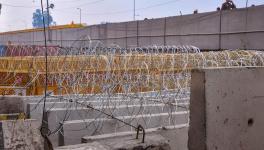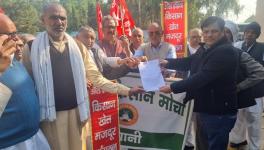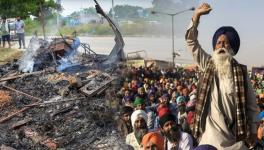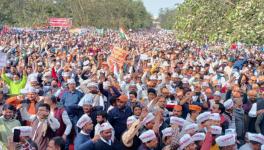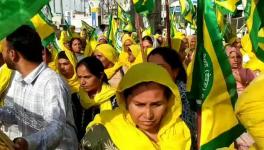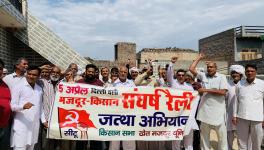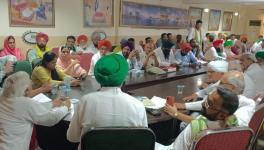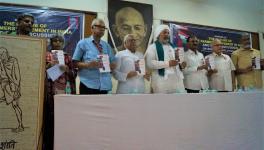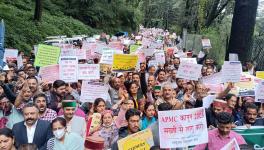Kisan Shaheed Smarak: How Artists Contributed to the Farmers’ Movement
Hundreds of kalashs (traditional pots) stand tall at Rajasthan’s Shahjahanpur protest site where farmers secure tents and prepare for the intense summer weather at Rajasthan’s Shahjahanpur. Made of earthen pots, iron rods and soil, the structure, modelled after a bed of flowers, honours the 370 people – as of April 14, 2021 – who died while participating in the farmers’ struggle.
.jpeg)
“You can cut all the flowers but you cannot keep spring from coming – Pablo Neruda said this a long time ago and recently I feel like this line resonates with the farmers’ struggle,” says professional designer and artist Lalon, in conversation with SabrangIndia.
A graduate from the National Institute of Design (NID) in Ahmedabad, Lalon had been following the farmers’ movement since the very beginning. He agreed with their ideology and arguments of the three farm laws forcibly by the central government. So, when he heard about the mitti satyagraha and its plan to honour martyred farmers, he saw it as a rare chance to offer his contribution.
“I had little time to conceptualise the idea, but I talked to farmer leader Yogendra Yadav and with my friend Shubham Singh, I headed to the border site,” he says.
They drove out to Shahjahanpur around the same time that members of the mitti satyagraha were concluding their march. Coordinator Guddi was pleasantly surprised at the time to see the enthusiastic response from people, especially villagers from Gujarat.
“We visited many historical places and hometowns of personalities in 23 states of India. We only faced police repression in Gujarat where officers cancelled our programmes. Yet villagers from around 400 villages sent their fistfuls of soil to us in Ahmedabad. The administration could not stop people’s emotion and individual freedom,” she says.
.jpeg)
Lalon travelled to Shahjahanpur without altercation, although he could not carry the required materials with him. As is obvious from photos of his finished work, the memorial was built with simplicity in mind. Iron rods, representing strength – a prime feature of the struggle according to Lalon – kalash, carrying a local essence and the soil from the satyagraha are the only three materials used to make the installation.
“At first, I thought we wouldn’t be able to build the memorial in time. But then, other farmers helped us out. People working at the langar came to help us in the evening. We even worked at night. You could see the familial feeling in the area,” he says.
.jpeg)
.jpeg)
Looking back at the visit, Lalon marvels how farmers tolerate the summer heat and the desert-cold at Shahjahanpur. His wife worried about his safety but he persisted thinking, “I have to take a stand at some point.” Police officials patrolling the area also appreciated the memorial. He claimed that some police officers were sympathetic to the protest but were compelled to follow orders.
“The best moment for me was when I walked up to the top of the structure for finishing touches and one of the 40-50 farmers helping out asked me to take off my shoes. He told me yaha kisi ki samadhi hai [this is a mausoleum],” says Lalon.
.jpeg)
Having witnessed the farmers’ protest sites first hand, he also dismisses “propaganda” claiming the movement was weakening. He points out that farmers have to return to their work during harvest season. Most helpers arrived at the memorial spot in the evening and worked throughout the night. He reasons that while they may not be physically present at protest sites, farmers were still a part of the movement in spirit, just like farmers from Gujarat who can’t voice their dissent.
“The Centre has no option but to repeal the laws. Otherwise, the situation will only worsen for the central leaders. They need to understand this,” he says.
Lalon’s faith in the movement perfectly mirrors professional sculptor Devanjan Roy’s conviction who built the first memorial for farmers just before the Republic Day parade. Unlike recent structures, the Bengali artist’s sculpture portrayed two specific figures of the farmers’ movement: farmer leader Chhotu Ram carrying belated Sant Ram Singh’s body while holding a plow with the other hand.
.jpeg)
Enraged by the recent security forces and barricades around protest sites, Roy headed to the protest sites to “fulfil his duty as a citizen” at a time when protests were in full swing. He worked on the memorial to express the idea that farmers, who worked as the backbone of the economy, deserved to voice their dissent against the laws.
He asks, “If people don’t want the laws, why force them? And if these laws must be enacted then why not provide farmers with a legal guarantee to support prices?”
While speaking to SabrangIndia, Roy condemned the mainstream media for spreading lies about the weakening of the movement. He claimed more farmers will head towards protest sites from West Bengal, once the assembly election finished.
“Farmers will not back down and the people of India support them,” he says.
Adding to this, Guddi points out that while farmers may not be collecting in large numbers in one area, hundreds of mahapanchayats were carried out in recent weeks.
“This is the movement’s strategy. Farmers are taking this time to spread their message through grassroot-level meetings,” she says.
Across India, farmers continue their battle against the three laws – the Farmers (Empowerment and Protection) Agreement on Price Assurance & Farm Services Act, the Farmer's Produce Trade and Commerce (Promotion and Facilitation) Act,and the Essential Commodities (Amendment) Act – along with a legal guarantee to Minimum Support Price (MSP). As the movement enters its fifth month, farmers now prepare for the hot summer.
Courtesy: Sabrang India
Get the latest reports & analysis with people's perspective on Protests, movements & deep analytical videos, discussions of the current affairs in your Telegram app. Subscribe to NewsClick's Telegram channel & get Real-Time updates on stories, as they get published on our website.










